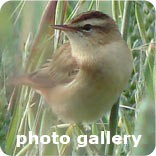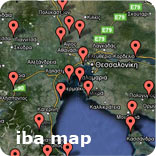GR001
National IBA Code
Northern Evros and Ardas riparian forest
Internationally recognized IBA Name
Parapotamio dasos voreiou Evrou kai Arda
National IBA Name
A1, B2, B3, C1, C6
Criteria under which the site qualifies as an IBA (according to Heath and Evans 2000)
26o 26’ 52.57’’ E, 41o 35’ 53.53’’ N
Co-ordinates of IBA centroid (longitude, latitude / Greenwich)
Altitude
Minimum and maximum altitude of IBA above sea level (100m resolution Digital Elevation Model)
Area
Area of the IBA in hectares (1 ha = 10 stremmata and 100 ha = 1 km2)
Region / Prefecture
Administrative Region and Prefecture in which the IBA is located. When an IBA lies in more than one Region or Prefecture, the latter are listed in a descending order according to the overlapping area.
Site description
Short description of the IBA, including information, where available, on geographical and topographical features, the main habitats, as well as land-uses occurring at the site.
Habitats
The main habitats recorded within the site and the proportion (%) of the IBA area covered by the specific primary habitat (spatial analysis of Corine Land Cover 2000 data). Primary habitat categories correspond to those of the World Bird DataBase of BirdLife International (WBDB).
Birds
Short section including information on the ornithological significance of the site and data on species present in nationally important numbers (e.g. hold a substantial proportion of the flyway population) but which are not listed in the bird table. The status of each species in the site follows in parenthesis (for categories see Season Status below).
Bird table

Interpretation of data fields in bird table
Species
Scientific bird names listed in taxonomic order following nomenclature in BirdLife Checklist Version 1 – May 2008 (https://www.birdlife.org/datazone/species/index.html). Globally Threatened Species are presented in bold font (according to IUCN Standards and Petitions Working Group 2008). Note: Trigger species are those with data in the ’Criteria 2000’ column of the bird table and are highlighted with dark-coloured lines.
Year
Year relating to population estimate presented. Where population estimates exist for more than one year, the time period is mentioned (e.g. 2003-7). Note: Species data prior to 1997 are reported as ’- 1997’.
Season Status
The season status of the species occurring in the IBA (WBDB categories). In case a species occurs in the IBA in more than one season status (e.g. Β and non-Β), data are presented in separate lines.
- R = Resident: a species known or thought to be present regularly all year (and hence, by implication, breed during the appropriate season) in the IBA.
- B = Breeding visitor: a species known or thought to visit regularly during the breeding season and breed in the IBA.
- non-B = Non-breeding visitor (during breeding season): a species known or thought to visit the IBA regularly during the breeding season, but not attempting to breed, usually because of breeding failure (or breeding not attempted) elsewhere at breeding sites, or congregation towards the end of the breeding season, or foraging by breeders at an IBA remote from their breeding site.
- W = Non-breeding visitor: a species known or thought to visit the IBA regularly during the non-breeding season. In the Eurasian and North American context, this encompasses ’winter’ i.e. a migratory species visiting the IBA to ’overwinter’
- P = Passage visitor: a species known or thought to occur regularly in the IBA during a relatively short period(s) of the year on migration between breeding and non-breeding ranges.
- U = Unknown: The season status of the species in the IBA is still unknown.
- Ex = Extinct: The species is thought to have become extinct from the IBA (this category within this edition is only used for trigger species which are considered extinct in the IBA)
Abundance
Categories describing the abundance of the species in the IBA (WBDB categories). Qualitative abundance data are given only when population figures are unavailable.
- Α = Abundant: encountered in large numbers in preferred habitat
- C = Common: encountered singly or in small numbers in preferred habitat
- F = Frequent: often, but not always, met within preferred habitat
- U = Uncommon: encountered sporadically in preferred habitat
- R = Rare: rarely seen, often implying less than 10 or so records
- P = Present: known to occur at the site, but not possible to assess abundance on available information
Minimum and Maximum Population
Estimate of the minimum and maximum population size of each species at the IBA. Where the population size is accurately known, minimum and maximum values are identical. Where the minimum value is well established, while the maximum value cannot be estimated, then ’0’ is entered in the field ’Maximum Population’. Where the population size estimate is not considered accurate enough, the ’Abundance’ field is completed.
Units
Units in which the population was estimated:
- P: Breeding pairs
- P*: Incubating breeding pairs
- I: Individuals
- Ι*: Individuals (adults and juveniles)
Data accuracy
Probable accuracy of data (WBDB categories):
- A = Good: based on reliable and complete or representative quantitative (survey) data
- B = Medium: based on reliable but incomplete or partially representative quantitative (survey) data
- C = Poor: based on qualitative information, but no (or potentially unreliable/unrepresentative) quantitative (survey) data
- U = Unknown
Criteria 2000
The criteria met by each trigger species within the IBA according to the 2000 evaluation (Heath and Evans 2000, for numerical population thresholds set for each species). Species with no data in this column did not fulfil criteria during 2000 and thus did not apply as trigger species. However, in a future evaluation some species would possibly meet criteria when applied against new population thresholds provided by BirdLife International.
Protection status
For each IBA this section presents the protection status in effect, the official name of the Protected Area, the total area of the Protected Area in hectares and the proportion of the area of the IBA covered by the Protected Area. The coverage (%) of IBAs by Protected Areas has been estimated for: a) SPAs and SCIs using Natura 2000 site boundaries (version 26, https://www.minenv.gr/1/12/121/12103/g1210300/g1210300000.html) and b) for the remaining sites using boundaries from the Greek Biotope - Wetland Centre (version 10/2007, https://www.ekby.gr/ekby/el/EKBY_PP_el.html#Protected%20areas_efarmogi). The categories of national, european and international Protected Areas mentioned within the current publication are:
European Protection Status
- SPA: Special Protection Area
- SCI: Site of Community Importance
National Protection Status
- NP: National Park
- NPA: Nature Protection Area
- EA: Ecodevelopment Area
- NFP: National Forest Park
- WR: Wildlife Refuge
- CHA: Controlled Hunting Area
International Protection Status
- RC: Ramsar Convention
- BC: Barcelona Convention
- BGR: Biogenetic Reserve
- BSR: Biosphere Reserve
- WHS: World Heritage Site
Conservation issues
The main threats relating to the IBA site and its trigger species are provided (threat categories follow Heath and Evans 2000 and WBDB). In addition, other conservation issues, such as management implemented at the site and the operation of a Management Body are mentioned.
References
Published and unpublished references (reports, Ornithotopos data, Midwinter Counts, etc.) relating to the specific IBA site.
Contributors
Those contributing data, texts or knowledge for each IBA site are mentioned here. Compilers of the initial IBA Data Entry Forms (1996) are listed first, followed by those contributing to the current publication (2008), wherever updates were attempted






